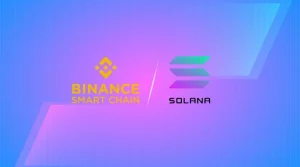So, we have a lot of wallets to choose from, but how do we transfer funds to the chain? We can transfer them from Binance account or use Binance Bridge.

And before we get started, it is necessary to pay attention to some conceptual foundations.
Binance Smart Chain supports the BEP-20 token standard, while Binance Chain (the backbone of Binance DEX) supports the BEP-2 standard. If you want to trade on Binance DEX, you need BEP-2 tokens. If you want to use dApps in BSC – BEP-20 tokens.
Transfer funds from Binance
If you are reading this article, you probably already have a Binance account. In this case, the easiest option is to transfer funds from your Binance account to your BSC wallet.
Make sure you select the Binance Smart Chain (BEP-20) network when withdrawing to an external wallet.
Binance Bridge
Another way to transfer assets to BSC is to use Binance Bridge.
You can choose native tokens from major blockchains such as Ethereum or TRON and convert them into wrapped tokens on BSC. The bridge works in both directions. You can track the on-chain reserve, which ensures that wrapped tokens in BSC are adequately backed by native tokens, on the Proof of Assets page.
If you prefer this way of transferring assets to BSC, please see the Binance Bridge guide.
Binance Smart Chain (BSC) Wallets
So, we have a wallet and we transferred funds to it. What can we do with our magical internet money? Let’s take a look at some of the most popular decentralized applications on the BSC network.
Keep in mind that these are just a few of the many applications. And every day there are more and more such new promising applications. You can track them on DefiStation, DappRadar or the Math dApp Store.
PancakeSwap
PancakeSwap is the number one automated market maker (AMM) on Binance Smart Chain.

Like Uniswap and SushiSwap, PancakeSwap allows you to exchange BEP-20 tokens.
You can also earn passive income by being a liquidity provider for one or more liquidity pools. When depositing funds, do not forget about intermittent losses.
AMM is the backbone of PancakeSwap, but that’s not all there is to the app. Among other things, you can also participate in lotteries and token sales, win NFTs, compete for places on the leaderboard – and more!
If all of these activities pique your interest, check out our detailed guide to PancakeSwap.
Venus
Venus is a lending protocol similar to Compound and Aave in Ethereum. It is a decentralized money market where you can borrow and lend BEP-20 tokens at auto interest rates.
Do you have free funds? Venus can be used to earn interest or as collateral for a loan to participate in income farming.
In addition, the decentralized stablecoin VAI is available on Venus and is backed by a basket of cryptoassets. Thus, Venus can be considered as an application that combines the capabilities of Compound and MakerDAO in the BSC network.
Autofarm
Autofarm is a yield aggregator at BSC. This is a kind of analogue of yearn in Ethereum. It automatically tries to find the best way for you to generate income from your investments.
BurgerSwap
BurgerSwap is another popular AMM in BSC. You can exchange BEP-20 tokens and provide liquidity.
Spartan Protocol
Spartan Protocol is a synthetic asset protocol in BSC. Like many other AMMs, it allows you to create liquidity pools for BEP-20 tokens.
At the same time, the Spartan Protocol opens up broader opportunities, such as the creation of synthetic assets backed by liquidity pools, as well as lending and on-chain derivatives.
Cream
Cream is a popular Ethereum lending protocol ported to BSC. Thanks to it, you can borrow and lend BEP-20 tokens.
